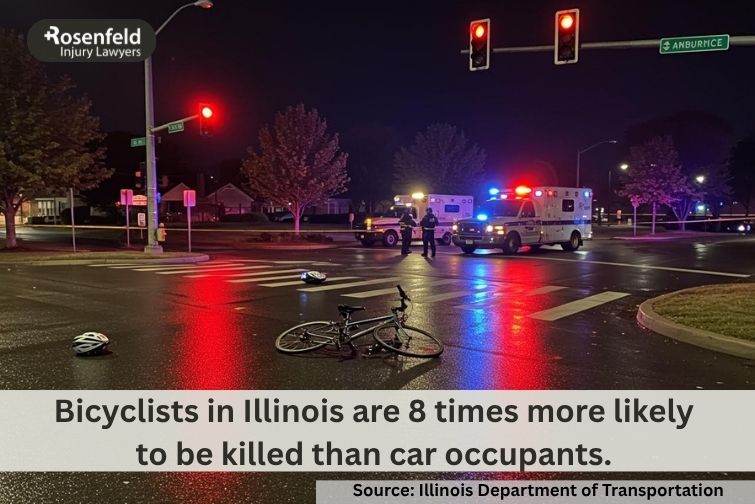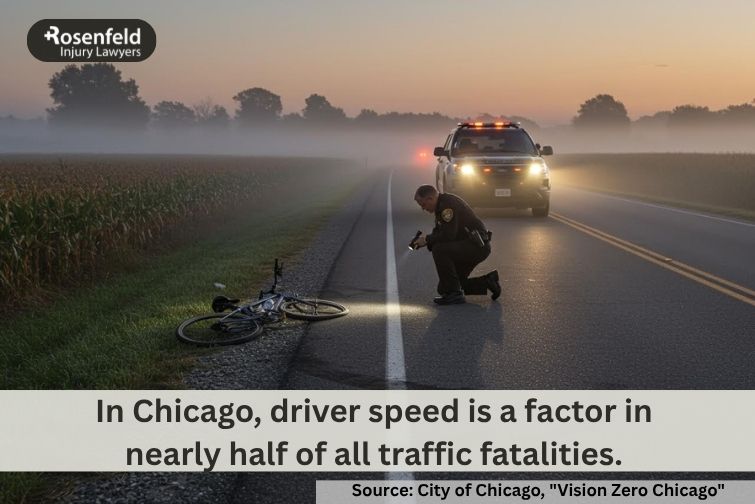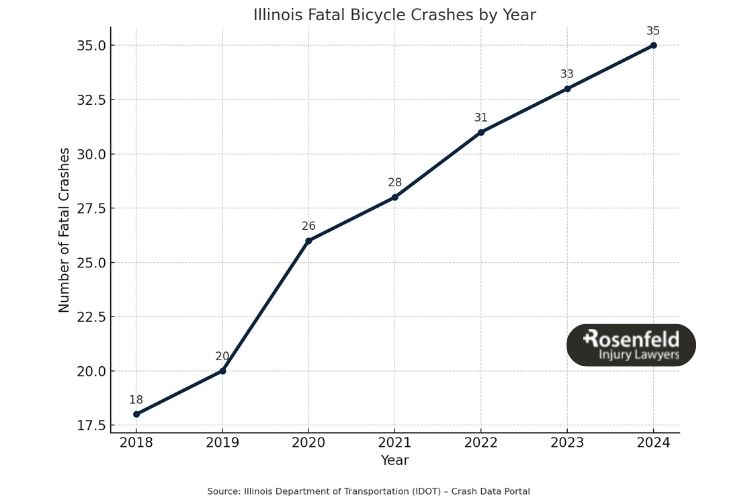Accident Lawyer
Illinois Fatal Bicycle Accident Statistics
At Chicago Bike Injury Lawyers, we represent cyclists and families affected by serious and fatal bike crashes across Illinois. The latest Illinois fatal bicycle accident statistics show that while overall traffic fatalities have leveled off, fatal bike accidents remain a persistent threat, especially in Chicago and Cook County.
Each number in the report represents a real person, a commuter, a student, or a parent, whose life was cut short by a preventable collision. Our firm stands with these families, helping them understand their legal rights and pursue justice through wrongful death claims. By raising awareness and improving bicycle safety across Illinois, we aim to make every ride safer for those who share the road.

How Many Bicyclist Fatalities Occur in Illinois Each Year?
According to the 2023 statistics published by the Illinois Department of Transportation (IDOT), there were 2,599 total bicycle crash injuries statewide, including 354 serious (A-level) injuries and 41 cyclist fatalities. While bicyclists represent only a small share of all traffic accidents, they make up 3.3% of all non-occupant fatalities, a sobering reminder of the disproportionate hazard riders face on Illinois roads.
Statewide Overview
While vehicle safety technology continues to improve, vulnerable road users like cyclists remain highly vulnerable. In Illinois, fatal bicycle accidents often occur in dense urban areas with heavy traffic and complex intersections. The combination of distracted drivers, speeding, and limited protected lanes has kept cyclist fatalities relatively steady despite safety initiatives.
Urban vs. Rural Trends
Of the 41 total bicyclist fatalities, 37 occurred in urban areas and 4 in rural regions. This indicates that most fatal bicycle crashes happen on city streets, major arterials, and local roads rather than rural highways.
Chicago, in particular, remains the state’s focal point for bicycle crashes, with thousands of annual collisions involving cars, trucks, and cyclists sharing crowded intersections. IDOT’s data also highlights that over 67% of all cyclist injuries statewide occur on city roads, underscoring the importance of urban infrastructure improvements.
Gender Breakdown
Men continue to face the highest danger of fatal and serious injuries in bicycle accidents. Of Illinois’ 41 cyclist deaths in 2023, 38 were male and 3 were female. This aligns with national research showing that men are more likely to ride in traffic and for commuting, increasing exposure to dangerous conditions.
Age Breakdown
Cyclist fatalities in Illinois span a wide range of ages, reflecting that serious crashes can affect both young and older riders. In 2023, IDOT recorded the following distribution of cyclist fatalities:
- 4 or Younger: 0 fatalities
- 5–9: 0 fatalities
- 10–14: 2 fatalities
- 15–19: 4 fatality
- 20–24: 2 fatalities
- 25–34: 2 fatality
- 35–44: 8 fatalities
- 45–54: 6 fatalities
- 55–64: 6 fatalities
- 65–74: 7 fatalities
- 75 or Older: 2 fatalities
- Unknown age: 2 fatalities
The average age of fatally injured bikers continues to rise, reflecting the growth of adult and commuter cycling across the state. Most fatal crashes occur among riders between 35 and 74 years old, suggesting that experienced cyclists are still at significant risk when sharing the road with careless drivers.

Fatal Bike Crashes by County
The 2023 data by county and city reveal that cyclist fatalities remain concentrated in the state’s most densely populated regions, particularly the Chicago metropolitan area.
Urban environments bring more pedestrians and cyclists, but they also present higher risks. Heavy traffic, distracted motorists, and limited protected lanes all contribute to a greater share of serious and fatal bicycle crashes. Below is a closer look at examples of how deadly bike accidents were distributed across different Illinois locations.
Cook County
Total bicycle accidents: 1,975
Fatal accidents: 14
Chicago: 1,410 total accidents, 7 fatalities
Oak Park: 22 total accidents, 0 fatalities
Schaumburg: 11 total accidents, 0 fatalities
Skokie: 30 total accidents, 1 fatality
Cicero: 43 total accidents, 0 fatalities
Cook County continues to lead the state in total and fatal bicycle accidents, accounting for over one-third of all bike-related collisions statewide. Chicago bicycle accident statistics reveal seven cyclist fatalities in 2023, representing nearly one in six of all deadly bike accidents in Illinois.
While the city has expanded its network of protected lanes and increased enforcement of speed limits and stop sign compliance under its Vision Zero plan, the data shows that dangerous interactions between cyclists and motor vehicles persist.
Many fatal collisions in Cook County occur on major arterials where drivers often travel above posted speed limits or fail to yield during right turns at intersections. Neighborhoods with high cycling traffic, such as the Near West Side, Logan Square, and South Side corridors, remain hotspots for injury and fatal accidents.
Despite progress, IDOT data makes clear that Chicago’s ongoing infrastructure upgrades must be paired with better driver awareness and enforcement to truly improve cyclist safety.
DuPage County
Total bicycle accidents: 157
Fatal accidents: 4
Naperville (partly in Will County): 28 total accidents, 0 fatalities
Wheaton: 8 total accidents, 0 fatalities
DuPage County reported a moderate number of serious accidents, including four bike rider fatalities in 2023. The county’s suburban design— involving wide multi-lane roads and limited separation between cyclists and traffic—contributes to the risk of collisions, particularly during morning and evening commuting hours.
While Naperville and Wheaton promote bike friendliness through shared-use paths and signage, accidents still occur when drivers open car doors into bike lanes or fail to look for riders while turning.
Will County
Total bicycle accidents: 47
Fatal accidents: 0
Joliet: 15 total accidents, 0 fatalities
Bolingbrook (partly in DuPage County): 5 total accidents, 0 fatalities
Will County experienced no recorded bike rider fatalities in 2023, though injury accidents remain common. Most incidents occur in suburban corridors connecting Bolingbrook, Joliet, and Lockport, where expanding development has outpaced the creation of dedicated bike infrastructure.
The absence of fatalities is encouraging, but it also underscores the importance of maintaining safe crossings, adding shoulder lanes, and enforcing driver awareness campaigns before accident rates rise with traffic growth.
Kane County
Total bicycle accidents: 89
Fatal accidents: 3
Elgin (partly in Cook County): 20 total accidents, 1 fatality
Kane County saw three cyclist deaths in 2023, most linked to collisions with turning vehicles on major collector roads. Elgin and Aurora, the county’s largest cities, both recorded fatal incidents, emphasizing that medium-sized urban centers face similar dangers as Chicago when it comes to driver negligence and infrastructure gaps.
IDOT data also shows that most fatal accidents here occurred on urban arterials, where speeding and limited visibility increase the likelihood of severe outcomes.
Kendall County
Total bicycle accidents: 7
Fatal accidents: 0
Aurora (partly in Kane, DuPage, and Will Counties): 47 total accidents, 1 fatality
Kendall County reported no bike rider deaths, making it one of the safest areas for cyclists statewide. However, the City of Aurora, which spans multiple counties, recorded one cyclist fatality, demonstrating that even riders in rural areas remain at risk when traveling across jurisdictions where bike infrastructure may be inconsistent.
Winnebago County
Total bicycle accidents: 35
Fatal accidents: 1
Rockford: 21 total accidents, 1 fatality
In Rockford, a single fatal bicycle accident occurred among 21 total accidents in 2023. Rockford’s downtown grid and nearby collector roads continue to experience intersection-related collisions, often when drivers fail to yield to cyclists crossing at green lights.
Local advocates have pushed for improved bike signage and better street lighting to help reduce nighttime accidents, which remain a key contributor to bike rider fatalities statewide.
Sangamon County
Total bicycle accidents: 38
Fatal accidents: 3
Springfield: 32 total accidents, 3 fatalities
Sangamon County, home to Springfield, reported one of the highest fatality rates relative to its total number of accidents. The three cyclist deaths in Springfield highlight the dangers of wide arterial roads without bike lanes and a lack of visibility during low-light conditions.
Many accidents involved motor vehicles making left turns or failing to notice cyclists while merging. The city’s ongoing efforts to improve road safety through education and traffic calming remain critical to preventing future tragedies.
Peoria County
Total bicycle accidents: 26
Fatal accidents: 2
Peoria: 23 total accidents, 2 fatalities
Peoria’s data underscores how mid-sized cities face similar challenges as large metros. Both of the county’s fatal accidents occurred within city limits, often near busy intersections. Efforts to improve bike safety education and expand shared-use paths have shown promise, but enforcement against inattentive drivers and speeding remains a continuing need to avoid bike and car accidents.
Lake County
Total bicycle accidents: 101
Fatal accidents: 2
Waukegan: 13 total accidents, 0 fatalities
Lake County’s 2023 numbers show a mix of commuter and recreational accidents, particularly near the north suburban corridor connecting to Chicago. Although the number of fatal accidents remains relatively low, higher traffic volumes and inconsistent bike lane markings present ongoing safety concerns, which lead to a large number of accidents involving bike riders.
Champaign County
Total bicycle accidents: 48
Fatal accidents: 1
Champaign: 28 total accidents, 0 fatalities
Champaign County, home to the University of Illinois, is known for its strong cycling community and infrastructure. Yet one fatal accident in 2023 demonstrates that even in bike-friendly school and college towns, collisions with cars and trucks while walking or cycling remain a serious risk. The city’s data suggests that inattention and failure to yield continue to be primary causes of cyclist injuries.

FAQs
What does data show regarding helmet use and bicycle safety?
Helmets are one of the most effective cyclist safety tools we can control. Broad reviews and national safety data indicate that helmet use cuts the odds of a head injury by 60% and reduces head/face/neck injuries by 47%. In fatal crashes, the most serious injuries are commonly head injuries, reinforcing why we encourage every rider, on every trip, to wear a properly fitted helmet.
How do Chicago bicycle accidents compare to other major cities?
Chicago recorded 7 bicyclist fatalities in 2023, according to reconciled IDOT/CDOT reporting. By comparison, New York City recorded 30 bicyclist fatalities in 2023, per NYCDOT’s annual crash report. In the Los Angeles region, Los Angeles County saw 26 bicyclist fatalities according to a 2023 BikeLA report.
Absolute totals vary with city size and riding volume, but the pattern across big cities is consistent: most fatal crashes concentrate on multi-lane arterials and high-traffic corridors, underscoring the need for separated facilities and lower speeds.
Can protected bike lanes help prevent traffic fatalities?
Yes. Multiple studies and federal guidance associate separated/protected bike lanes with meaningful crash reductions. FHWA reports that converting traditional bike lanes to separated lanes with low-cost delineators can reduce bicycle–vehicle crashes by up to 53%.
City-level research also links greater protected lane mileage with lower fatal crash rates for all road users, not just cyclists, likely due to traffic calming and fewer conflict points.
What legal options do families of fatally injured bike accident victims have in Illinois?
We help families pursue civil claims under two complementary paths:
- Wrongful Death (740 ILCS 180/2): Brought by the personal representative for the benefit of next of kin, typically seeking compensation for losses such as grief, loss of support, and funeral/burial costs. In most cases, the statute of limitations is two years from the date of death (with specific exceptions in limited circumstances).
- Survival Action (755 ILCS 5/27-6): Brought by the estate to recover damages the decedent could have claimed between injury and death (e.g., conscious pain and suffering, medical expenses). Survival claims also generally have a two-year limitations period, subject to case-specific rules.
In these cases, we typically pursue compensation through civil claims against negligent drivers (and their insurers) and, where supported by the evidence, against additional responsible parties (e.g., employers via vicarious liability).
Book a Free Consultation
At Chicago Bike Injury Lawyers, we know that losing a loved one in a deadly bike accident is devastating. Our firm helps families across Illinois understand their legal rights and pursue justice through civil wrongful death claims against negligent motorists and other responsible parties.
We handle every step of the process, from investigating the accident and reviewing police reports to working with experts and negotiating with insurers. Our goal is to help you find answers, explain laws and accountability, and give you a sense of closure.
Our Chicago bicycle accident law firm handles every case on a contingency fee basis, which means you won’t pay any upfront costs or attorney fees unless we successfully recover compensation on your behalf.
If your family has lost a loved one in a bicycle accident in Chicago or anywhere in Illinois, contact us for a free, confidential consultation. We’re here to help you take the next step toward justice and safer roads for every cyclist.
Content reviewed by Chicago bicycle accident lawyer Jonathan Rosenfeld of Rosenfeld Injury Lawyers LLC, who holds negligent drivers, municipalities, and corporate defendants accountable to protect injured cyclists and their families, and is a trial lawyer recognized by National Trial Lawyers, Best Attorneys of America, and the National Association of Personal Injury Attorneys for high-severity injury claims.








